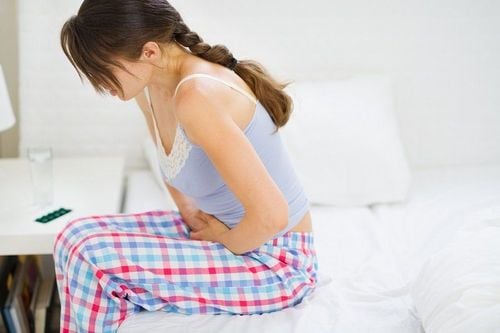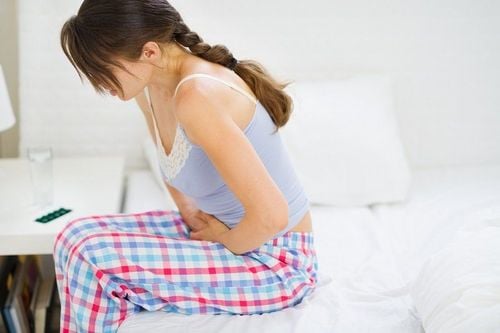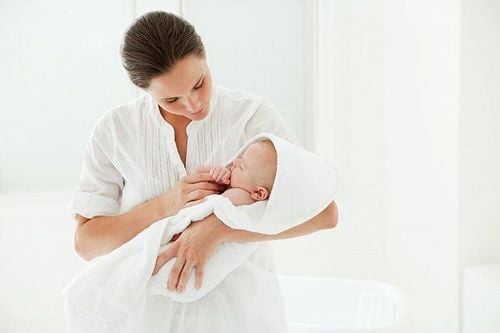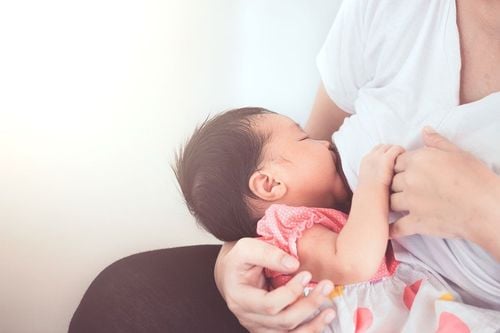This is an automatically translated article.
The article was professionally consulted by MSc, Dr. Trinh Thi Thanh Huyen - Obstetrician and Gynecologist - Department of Obstetrics and Gynecology - Vinmec Hai Phong International General HospitalAfter giving birth, a woman's body will have to face significant changes. Knowing the common post-pregnancy problems will help you better prepare to deal with the physical and emotional changes that come with pregnancy.
1. Some common problems after giving birth
Women can experience a wide range of postpartum problems, each with their own symptoms and severity. Some common problems are:
Postpartum infections (including infections of the uterus, pelvis, bladder, kidneys) Excessive bleeding after delivery Pain in the perineum area (between the vagina and rectum) Vagina Stretch marks Breast swelling, blocked milk ducts Hemorrhoids and constipation Hair loss Urinary incontinence Postpartum depression Difficulty having sex Difficulty getting back into pre-pregnancy shape
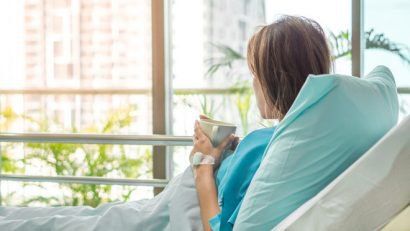
2. Causes and treatment of postpartum problems
2.1. Postpartum hemorrhage
Although some postpartum bleeding is normal, cases of heavy or hemorrhagic bleeding occur in only about 2% of births, usually after labor for a long time, multiple births or an infected uterus.
Postpartum hemorrhage is the third most common cause of maternal death after childbirth, usually occurring because the uterus does not contract normally after the placenta is delivered or because fragments of the placenta or amniotic membranes remain. in the uterus, cervix, or vagina. As soon as the baby and placenta are delivered, you will be monitored to make sure the uterus is contracting as normal. If the bleeding is severe, your doctor and paramedics will massage your uterus to help it work properly, or you may be given a synthetic hormone called oxytocin to help stimulate the uterus. uterine contractions. In addition, your doctor may order a pelvic exam to find the cause of the bleeding. If you lose a lot of blood, you will be given a blood transfusion.
If bleeding occurs after a week or two after birth, it may be caused by a piece of placenta left in the uterus. If so, the tissue will be surgically removed.
Trắc nghiệm: Những điều cần biết về kiêng cữ sau sinh
Sau sinh, cơ thể sản phụ sẽ có rất nhiều sự thay đổi, việc thực hiện tốt các kiêng cữ sau sinh và bổ sung đầy đủ các chất dinh dưỡng cho cơ thể sẽ giúp ích rất nhiều trong quá trình hồi phục sức khỏe. Bài trắc nghiệm dưới đây sẽ giúp mọi người có cái nhìn tổng quan về kiêng cữ sau sinh và thực hiện sao cho phù hợp nhất.The following content is prepared under supervision of Thạc sĩ, Bác sĩ y khoa, Tạ Quốc Bản , Sản phụ khoa , Khoa Sản phụ khoa - Bệnh viện Đa khoa Quốc tế Vinmec Phú Quốc
2.2. Uterine infection
Normally, the placenta separates from the uterine wall during delivery and is expelled from the vagina within 20 minutes of delivery. If fragments of the placenta remain in the uterus, an infection can result.
Infection of the amniotic sac (the sac of water that surrounds the baby) during labor can lead to a postpartum infection of the uterus. Symptoms include: high fever, fast heartbeat; abnormally increased white blood cell count; an enlarged, tender and painful uterus; A foul-smelling discharge usually indicates a uterine infection. When the tissues around the uterus are also infected, you may experience severe pain and fever. Uterine infections can often be treated with injections of antibiotics, to prevent potentially dangerous complications such as septic shock.
2.3. Surgical wound infection
If the incision is red, swollen or oozing pus, you should immediately see a doctor for timely treatment. You must not scratch the incision. If it's itchy, you can use lotion to relieve it.
2.4. Kidney infection
Kidney infection, which can occur if bacteria spreads from the bladder, includes symptoms such as high fever, back or side pain, constipation, and painful urination. When you have a kidney infection, your doctor usually prescribes you to inject or take antibiotics. You will need to drink plenty of fluids and will be asked to take a urine sample at the start and end of treatment to screen for any remaining bacteria.
If you have a high fever, tell your doctor right away because it could be a sign of a postpartum infection.
2.5. Pelvic pain
For women who have vaginally delivered, pain in the perineum (the area between the rectum and the vagina) is quite common. These soft tissues can be stretched or torn during childbirth, causing them to swell, bruise, and hurt. This discomfort may also be aggravated by an episiotomy.
After giving birth, your body begins to recover, the discomfort will lessen. You must wipe yourself from front to back after using the toilet to avoid spreading bacteria from the rectum.
If sitting is uncomfortable, you can use a pillow to help relieve pressure on the perineum. Using pain relievers (don't use aspirin if you're breastfeeding) can also help.
When you feel pelvic pain, pelvic floor exercises can help restore your vaginal muscles. However, if your vaginal pain becomes worse and persists, stop exercising and let your doctor know.
2.6. Vaginal bleeding
Vaginal bleeding is common during the first few weeks after giving birth. This waste, which includes blood and the remains of the placenta, is called lochia. During the first few days after giving birth, the discharge is bright red and may include blood clots. The discharge will gradually turn pink, then white, or yellow before stopping completely. Bright red discharge may return at other times, such as after breastfeeding or vigorous exercise, but vaginal bleeding improves after 10-14 days.2.7. Breast swelling
When milk arrives (about two to four days after giving birth), your breasts may become very large, hard and painful. Breast swelling will decrease when you breastfeed or if you don't breastfeed for about 3 days, your body will stop producing milk.
You can reduce discomfort by wearing a well-fitting support bra and applying an ice pack to your chest. If you're breastfeeding, you can massage your breasts or use a breast pump to relieve engorgement. If you are not breastfeeding, do not take a hot bath and express milk as this will only make your body produce more milk. You can take pain relievers to improve this condition until your milk supply is completely exhausted.
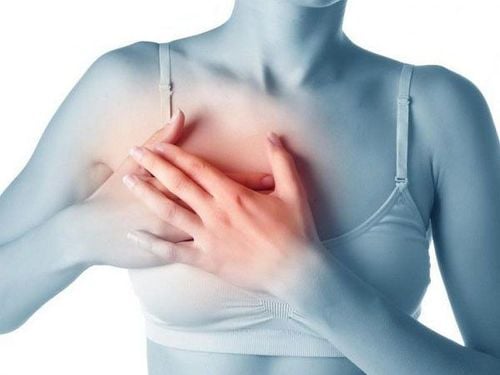
2.8. Breast infection
Mastitis or breast infection is usually indicated by a painful, red area on the breast or possibly the entire breast. A breast infection - which can be caused by bacteria from stress, exhaustion or cracked nipples - can be accompanied by fever, chills, fatigue, headache, nausea, vomiting. If you experience any of these symptoms, immediately notify your doctor for prompt treatment. You may be prescribed antibiotics.
Mastitis does not affect breast milk. It is important that you rest and drink plenty of water. You should use a warm towel to compress to reduce discomfort and avoid clogged milk glands after birth. You should limit the use of bras when you have a breast infection.
2.9. Milk gland blockage
Clogged milk glands, which can cause redness, pain, swelling or a lump in the breast, resembling mastitis. However, unlike a breast infection, blocked ducts are not accompanied by flu-like symptoms.
The medical staff will perform breast massage to solve the blocked milk duct. However, if the condition does not improve, you should go to a medical facility for treatment.
2.10. Stretch
Hemorrhoids and constipation, which can be aggravated by the pressure of the uterus and fetus, are quite common in pregnant and postpartum women. Over-the-counter topical medications and sprays, along with a diet rich in fiber and fluids, can often help relieve constipation and swollen hemorrhoids.
Do not use laxatives or enemas without consulting your doctor, especially if you have had an episiotomy or have stitches in the perineal area.
2.11. Hemorrhoids and Constipation
Hemorrhoids and constipation, which can be aggravated by the pressure of the uterus and fetus, are quite common in pregnant and postpartum women. Over-the-counter topical medications and sprays, along with a diet rich in fiber and fluids, can often help relieve constipation and swollen hemorrhoids.
Do not use laxatives or enemas without consulting your doctor, especially if you have had an episiotomy or have stitches in the perineal area.
2.12. Hygiene incontinence
Urinary incontinence, especially when laughing, coughing or straining, is often caused by the bladder dilating during pregnancy and delivery. Usually, over time, your bladder will return to normal. You can speed up this process by doing exercises.
Besides, you can use a protective pad when you can't control your own hygiene needs. Your doctor will prescribe you medication to treat this condition. If you experience pain, burning, or discomfort while urinating, you should tell your doctor right away as this is a sign of a bladder infection.
2.13. Hair loss
Postpartum hair loss usually lasts from 5-6 months. During pregnancy, hormones increase, hair loss is not really a concern, so you are not too concerned about this issue. However, a few months after giving birth, many women begin to feel apprehensive when they see their hair falling out at an alarming rate. However, postpartum hair loss only occurs in a short period of time after giving birth, you do not need to worry too much.
2.14. Postpartum depression
Most women experience depression after giving birth. The change in hormone levels and the accompanying care of a newborn is not an easy thing that leaves many mothers feeling anxious, overwhelmed or even angry. For those with mild depression, it ends within a few weeks of giving birth
Depression that lasts longer or gets worse after giving birth is called postpartum depression (PPD). PDD affects 10% to 20% of women who have just given birth. PPD usually manifests itself two weeks to three months after birth, and includes signs such as feelings of anxiety or hopelessness. Lack of sleep, hormone changes, and physical pain after childbirth are all triggers for PPD, leaving some women feeling burdened in their new role. They have a hard time overcoming feelings of loneliness, fear, or even guilt.
To treat postpartum depression, pregnant women need help from family members and friends. Share your feelings with them and ask them to help take care of the child. If the condition becomes severe, you should consult your doctor for prompt treatment. For women with postpartum depression, accompanied by thoughts of hating their own child, wanting to commit suicide, often experiencing hallucinations or abnormal behavior, immediate medical intervention is required. These symptoms could be warning signs of a more serious health condition like postpartum psychosis.
Psychology Clinic - Vinmec International General Hospital officially came into operation in April 2019, has the function of examining, consulting and outpatient treatment of psychological problems and psychological health. With modern equipment, Vinmec Mental Health Clinic is currently cooperating with experienced professors and experts. Along with the combination of implementing psychological tests, specialized psychotherapy for diagnosis and treatment, in order to bring the best medical examination and treatment effect.
2.15. Difficulty having sex
You can have sex once you feel comfortable - both physically and emotionally. After giving birth, it takes time for the vagina to return to normal - usually around four to six weeks (less if you don't have an episiotomy). After a cesarean section, your doctor will advise you not to have sex for at least 6 weeks after giving birth.
You may find it difficult to have sex, even painful, until three months after giving birth, especially if you are breastfeeding. Because breastfeeding lowers your body's levels of the hormone estrogen, your vagina may be unusually dry during the postpartum period. Using a lubricant can help alleviate discomfort. After giving birth, you often feel pain in the perineum.
Even after your body heals, you don't feel as excited about sex as before you gave birth. Physical exhaustion coupled with new worries and emotional changes can cause you to lose your sex drive. Share your feelings with your partner so that you can empathize and share with each other.
2.16. Get in shape before pregnancy
Exercise is one of the best ways to lose weight after pregnancy, regain energy, relieve stress and restore the body. Unless you had a cesarean section or had pregnancy complications (in which case you should talk to your doctor), you can resume moderate exercise once your body has recovered.
After giving birth, you can choose sports such as walking or swimming. However, because of the risk of bacteria entering the vagina, you shouldn't swim for the first three weeks after giving birth.
Exercises such as sit-ups or leg lifts are one of the best options for postpartum women to get in shape.
You can participate in clubs, fitness classes specifically for postpartum mothers to create connections with other mothers and share knowledge of child rearing as well as exercise. This will help you feel more motivated and work harder.
After giving birth, you need to monitor your own health, if you see any abnormal signs, you should immediately notify your doctor for timely examination and treatment. Because they can be warning signs of serious complications after birth.
Heavy Vaginal Bleeding Persistent pain in the perineum Fever over 37.5 degrees Chest pain Pain or burning when urinating, or frequent and sudden urination. Nausea or vomiting. You feel depressed, hallucinated, paranoid, disgusted with your children, or have thoughts of suicide.
Please dial HOTLINE for more information or register for an appointment HERE. Download MyVinmec app to make appointments faster and to manage your bookings easily.
Article reference source: Webmd.com






